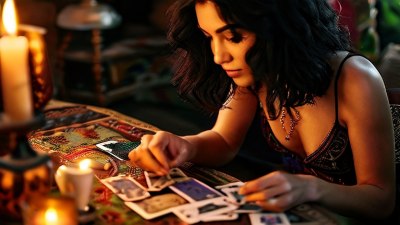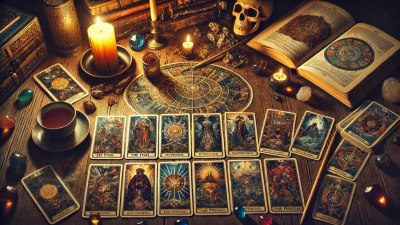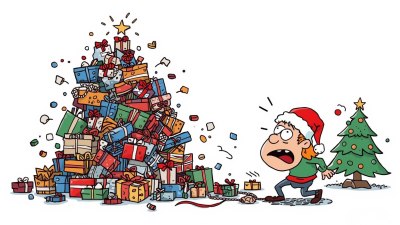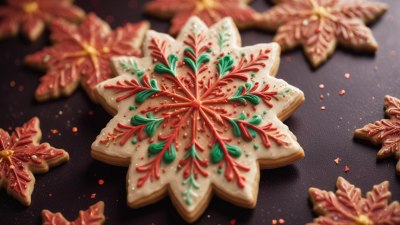How to Use Tarot for Self-Reflection 🔮🃏
Learn how to use tarot as a tool for self-reflection and personal growth. Explore simple tarot spreads, journaling techniques, and intuitive card reading to gain insights into your inner world and navigate life’s challenges with clarity!
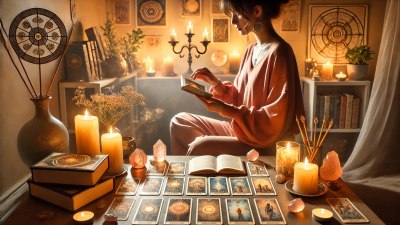
This image was created with the assistance of DALL·E
Tarot is often associated with fortune-telling and mystical insights into the future, but one of its most powerful and meaningful uses is for self-reflection. The rich symbolism in tarot cards can help us explore our inner thoughts, emotions, and experiences, offering guidance for personal growth and deeper self-understanding. When used mindfully, tarot becomes a mirror that reflects your subconscious mind, helping you navigate life’s challenges and decisions with greater clarity.
In this article, we’ll explore how to use tarot as a tool for self-reflection, guiding you through practical steps and exercises to connect with your inner self. Whether you’re a beginner or an experienced tarot reader, these techniques will help you gain valuable insights into your life and personal journey.
1. Set Your Intention for Reflection ✨
Before you begin working with the cards, it’s important to set a clear intention. Unlike a tarot reading for prediction or advice, using tarot for self-reflection is about gaining insight into your emotions, thoughts, and behaviors. By setting an intention for self-awareness, you open yourself to the messages the cards have to offer, allowing them to guide you through introspection.
How to Set an Intention: Take a few moments to think about what aspect of your life or self you’d like to explore. Is there a challenge or pattern you’ve noticed in your thoughts or actions? Are you seeking clarity on how you’re feeling about a situation? State your intention clearly, either silently or aloud. For example:
- “I want to reflect on how I’m handling my current relationships.”
- “I want to gain insight into why I’m feeling stuck in my career.”
- “I want to understand what emotional patterns are affecting my self-esteem.”
By focusing on self-reflection, you allow the cards to guide you toward deeper self-awareness, rather than focusing solely on external outcomes.
2. Choose a Simple Tarot Spread for Reflection 🌿
There are many tarot spreads designed for self-reflection, but you don’t need anything too complicated to get started. A simple spread can offer powerful insights without overwhelming you with too much information. Here are two easy spreads to try:
The Three-Card Spread 🃏🃏🃏
The classic three-card spread is perfect for reflecting on different aspects of your life. This spread gives you a snapshot of your past, present, and future thoughts or behaviors around a particular issue.
- Card 1 (Past): What past experiences or emotions are influencing you?
- Card 2 (Present): What is happening now, and how are you currently feeling or acting?
- Card 3 (Future): What direction are you heading in if you continue on this path?
This spread helps you gain clarity on patterns that may be affecting your current mindset and can reveal areas where you might want to change your approach.
The Self-Reflection Spread 🌟
This spread is designed specifically for inner exploration and self-awareness. It uses five cards to dive deeper into your current state of mind and emotions.
- Card 1: How do I see myself right now?
- Card 2: What is my greatest strength at this moment?
- Card 3: What is my biggest challenge or weakness?
- Card 4: What unconscious belief or emotion is influencing me?
- Card 5: What can I do to grow and improve?
This spread offers a balanced look at your inner world, highlighting both your strengths and areas for growth.
3. Journal Your Tarot Reflections 📖✍️
Tarot is a deeply personal practice, and one of the best ways to get the most out of your readings is by journaling your reflections. Writing down your thoughts allows you to process the insights you’ve gained from the cards and track your personal growth over time.
How to Journal: After completing your tarot reading, take a few moments to write down the cards you pulled and your interpretations of them. Reflect on how the cards relate to your current situation or feelings, and consider any patterns or themes that stand out to you.
- What emotions or thoughts came up as you interpreted the cards?
- How do the cards resonate with your current challenges or goals?
- What steps or actions do the cards suggest you take?
By keeping a tarot journal, you create a written record of your self-reflection, which can be revisited later to see how your thoughts, feelings, and circumstances have evolved.
4. Engage with the Cards Intuitively 🌙
While traditional tarot card meanings provide helpful guidance, don’t be afraid to engage with the cards intuitively. Tarot is not just about memorizing card definitions—it’s about tuning into your own inner wisdom and the messages that come through as you connect with the imagery.
4.1. Trust Your Instincts: As you look at each card, pay attention to what stands out to you. Are there symbols, colors, or characters that seem especially meaningful? How do they make you feel? What do they remind you of in your current life? Trust your instincts and let the cards guide your reflections, even if your interpretations deviate from traditional meanings.
4.2. Ask Yourself Questions: Engage with the cards by asking yourself deeper questions as you explore the images. For example, if you draw the Hermit, ask:
- Am I feeling the need to withdraw and reflect?
- Is there wisdom within me that I’m not fully tapping into?
- How can I create more space for self-reflection in my life?
By using your intuition, you create a more personal and meaningful dialogue with the cards, allowing them to reflect your unique experiences and emotions.
5. Use Tarot for Daily Self-Check-Ins ☀️🌙
Incorporating tarot into your daily routine can help you stay grounded and focused on self-awareness. By drawing a single card each morning, you can start your day with clarity and intention, reflecting on how the energy of the card resonates with your thoughts and emotions.
5.1. Daily Card Draw: Each morning, shuffle your deck and draw one card. Spend a few moments reflecting on what the card means to you and how it might influence your day. Ask yourself:
- What energy or theme does this card bring into my life today?
- How can I apply this card’s message to my thoughts, actions, or decisions?
- What is this card telling me about my current state of mind or emotions?
5.2. End-of-Day Reflection: In the evening, revisit the card you drew and reflect on how it showed up in your day. Did its message resonate with your experiences? How did it help guide your thoughts or actions?
By using tarot for daily check-ins, you create a consistent practice of self-reflection, allowing you to stay connected with your inner self and make more mindful choices.
Tarot as a Mirror for the Soul 🔮💖
Using tarot for self-reflection is a powerful way to gain clarity, tap into your intuition, and explore your inner world. By approaching the cards with an open mind and heart, you can uncover hidden truths about your emotions, behaviors, and life path. Remember, tarot is a tool for guidance and growth, not just prediction. It’s about developing a deeper relationship with yourself and using the insights you gain to make positive changes in your life.
Whether you’re exploring past patterns, understanding present emotions, or preparing for future challenges, tarot is a beautiful tool to help you reflect on your journey and navigate life with more self-awareness.





